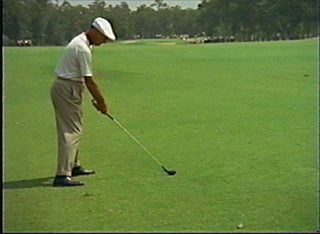Learned a long time ago from some top-notch professional instructors that when leading professional golfers struggle, it’s so very often because of their setup.
The late Ken Venturi once wisely said: Bad swings don’t produce bad shots, bad lines produce bad shots. Those “lines” Venturi was referring to are the lines in a golfer’s setup position.
On a recent Golf Channel edition of Swing Expedition, host Chris Como visited with well-known instructor Rick Smith at Smith’s South Florida facility. They talked about setup, among other things and Smith brought up Ben Hogan’s address position.
Hogan set up this way:
Shoulders and hips square to the target line (parallel left) with his stance in a “closed” position, meaning his right foot is dropped back off that square line.
This helps get that inside-to-square-to-inside swing path that great players accomplish.
Look at the picture above and you will see that Mr. Hogan shows that famous setup position that made him such an incredibly accurate ball-striker.
Went out this past week and focused on getting that address position correct and the results were very, very impressive (at least they impressed me). The driver accuracy was excellent and contact was solid.
Solid contact is the key to getting more distance as well.
At Rick Smith’s facility, he had a spot on his practice range where he had drawn a straight white line with spray paint then added a bit of a inside path on one spot for the takeaway and another farther up on the line to show how the clubhead should finish, going left of the straight white line. Great visual.
Another tip to make sure your takeaway is correct is to put a tee in that hole at the butt end of the grip. Practice your backswing and make sure that the tee points at the square line when you’re waist high on the takeaway.
These are fairly simple concepts and easy to practice.
Click on this link to watch Hogan swing on the perfect lines:
Too many players get caught up with too many swing thoughts. Try these simple ones.
Use the Hogan setup and visualize that inside-to-square-to-inside path.
It works!


































